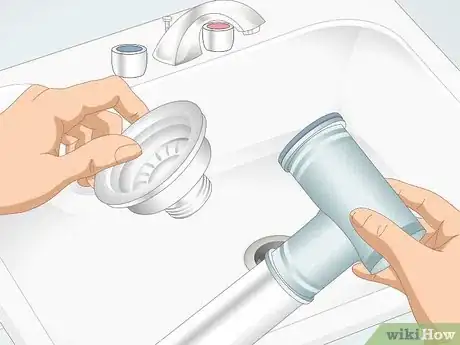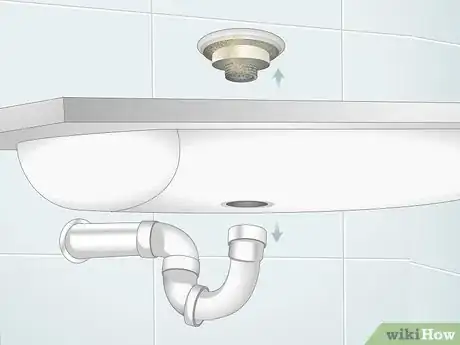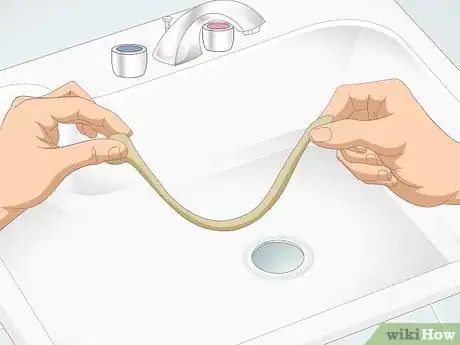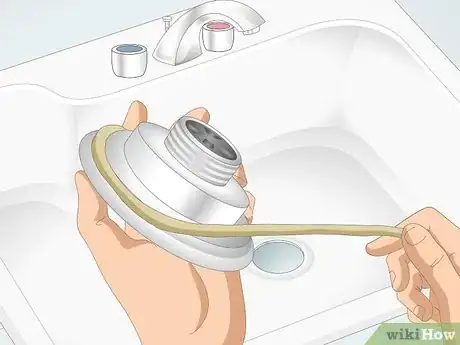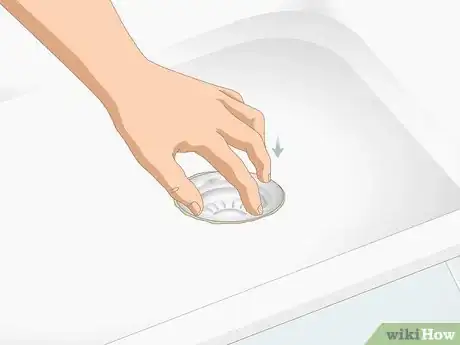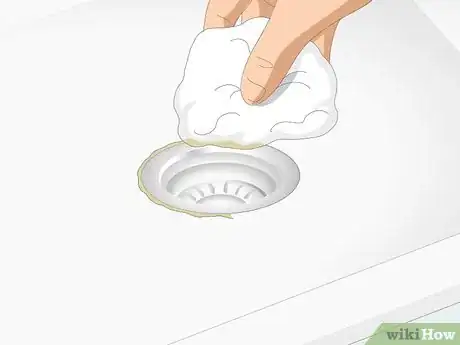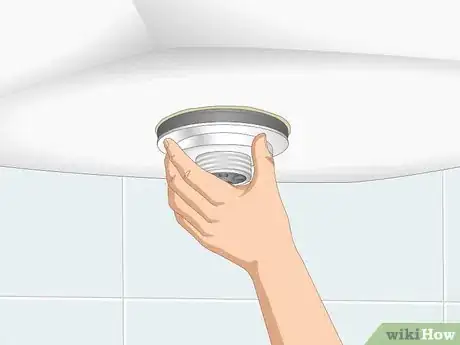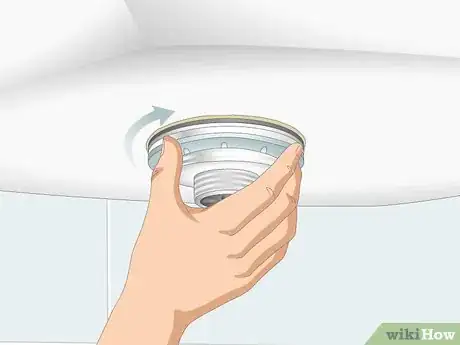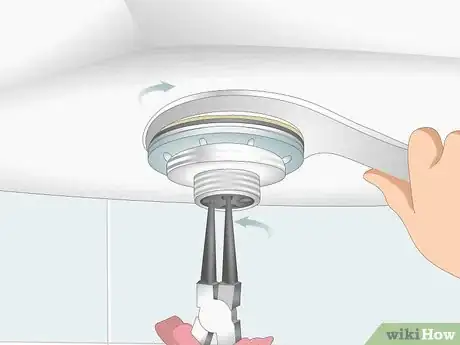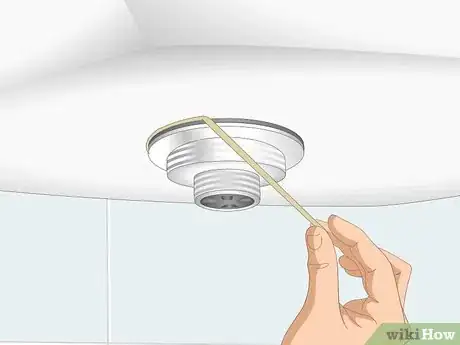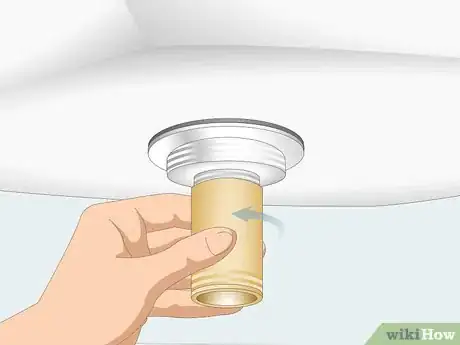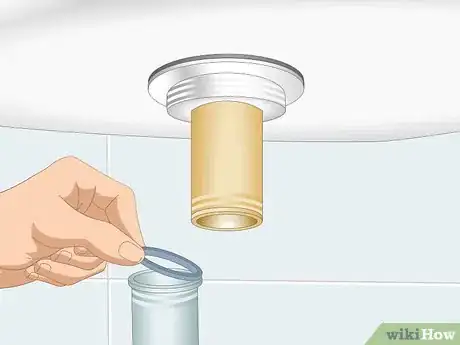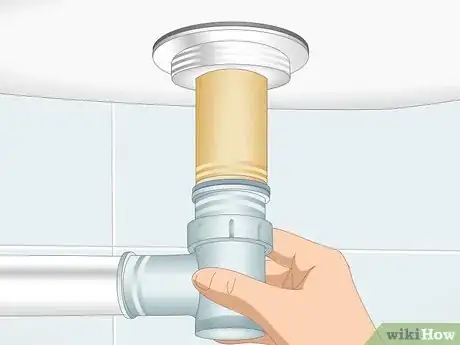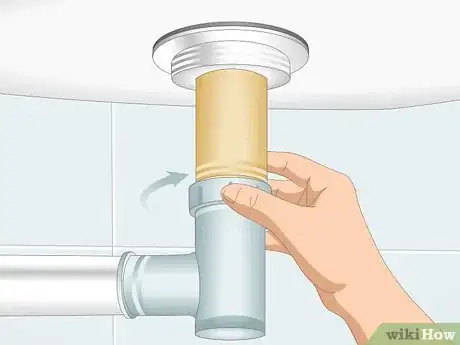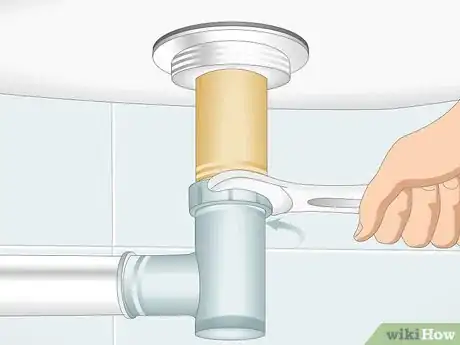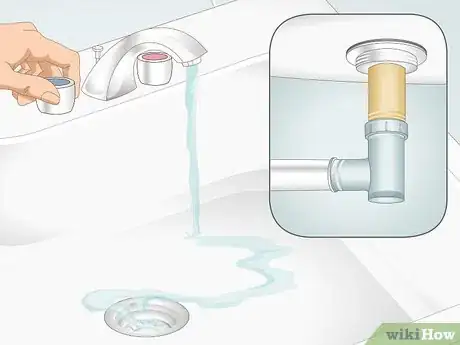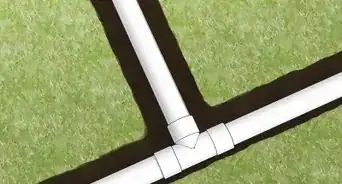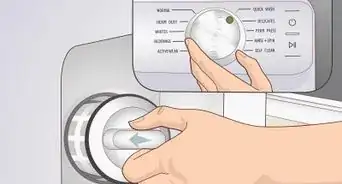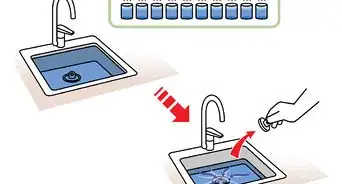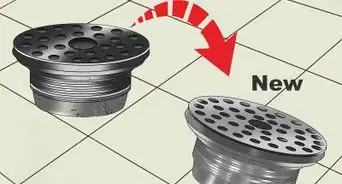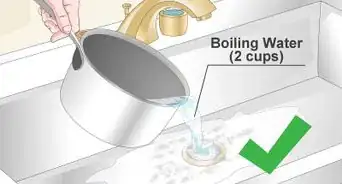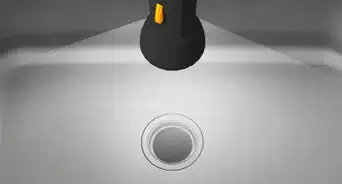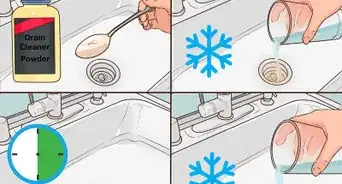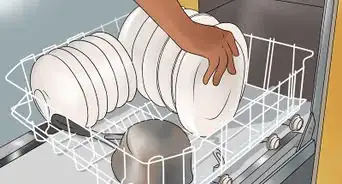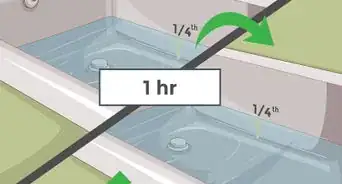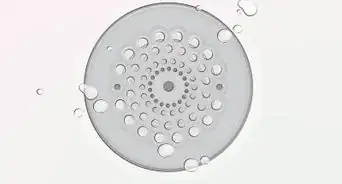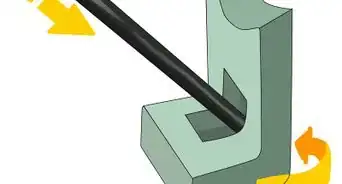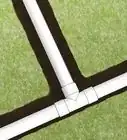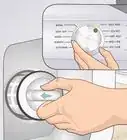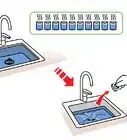This article was co-authored by David Balkan. David Balkan is a Professional Plumber, CEO of Balkan Sewer and Water Main Service, and President of Balkan Sewer and Drain Cleaning. As a hands-on owner of these companies for over 40 years, David is knowledgeable about water service lines, sewers, and drain line issues. David is a Committee Chairman of the Master Plumbers Council and has sat on the Executive Committee of the Sub Surface Plumbers Association of New York for over 30 years. His knowledge and solution-oriented approach contributed to Balkan Sewer and Water Main Service being the largest and most trusted service in New York City and the recipient of the 2017 Angie’s List Super Service Award.
There are 14 references cited in this article, which can be found at the bottom of the page.
This article has been viewed 141,853 times.
If your kitchen sink drain is corroded and leaking, installing a new basket strainer is an easy way to solve the problem. Start by adding plumber’s putty to the underside of the basket strainer and fit it into the drain hole at the bottom of the sink. Then, tighten the nut with a basket wrench to secure it in place. You can then fit a brass tailpiece onto the bottom of the basket strainer, reconnect the drainpipes, and you’re done!
Steps
Inserting the Basket Strainer
-
1Choose a drain assembly kit that fits your sink. A drain assembly kit will contain a basket strainer, locking nut, rubber washer, friction ring, and a brass tailpiece to connect the the drain to the drainpipes. Make sure you have all of the pieces you’ll need to install your drain and make sure the drain fits into the drain hole at the bottom of your sink.[1]
- Measure the drain hole to make sure you choose a basket strainer that fits.
- If your sink has an existing basket strainer, use it as a model to help purchase your new one so you know it will fit.
- Make sure the tailpiece fits your drainpipes as well, and choose a brass tailpiece so it lasts longer.
- You can find sink drain assembly kits at your local hardware store, at department stores, and online.
-
2Disconnect the drainpipe and remove the existing strainer if there is one. Use a pair of pliers to turn the metal fittings on the drainpipe and then separate it from the tailpiece on the underside of the drain. Then, unscrew the nut on the underside of the basket strainer with a basket wrench and pull out the strainer from the drain hole at the bottom of the sink.[2]
- If you’re installing a kitchen sink drain onto a sink that’s already installed and has drainpipes hooked up to it, you need to disconnect them before you install the drain.
- Be careful not to damage the pipes with the pliers when you separate them.
Advertisement -
3Form a rope with a piece of plumber’s putty. Take a small amount of plumber’s putty from the container and knead it in your hands for a minute or so to warm it up and make it more pliable. Then, use the palms of your hands to roll the putty into a cylindrical rope shape about 4–5 inches (10–13 cm) long.[3]
- Guage how long the rope needs to be by wrapping it around the bottom of the basket strainer.
- Form the rope of putty with an even diameter.
- You can find plumber’s putty at hardware stores, at department stores, and online.
-
4Apply the putty to the underside of the lip of the basket. Flip the basket strainer upside down and use your fingers to press the plumber’s putty onto the underside of the lip. Wrap the putty around the entire basket strainer, pressing it into place.[4] [5]
- Don’t press the putty is hard that the rope is spread thin and the putty hangs over the lip of the basket.
- If the rope of putty is too long, simply pull off the excess length and connect the two ends of the putty.
-
5Press the basket into the drain hole at the bottom of the sink. Hold the basket strainer over the drain hole and gently push it into place so it’s even and the lip of the strainer is flush against the edge of the drain hole. The plumber’s putty will expand in the space between the lip of the basket strainer and the drain hole as you press down to create a watertight seal.[6]
- Push straight down to create an even seal.
- The putty will dry and form a washer, so don’t press so hard that it’s forced out of the sides of the basket strainer.
-
6Wipe off the excess putty on the underside of the sink with a cloth. The plumber’s putty will have expanded and an excess amount may be hanging or pooling at the bottom of the basket. Use a clean cloth to wipe away the excess putty so the seal is clean and consistent.[7]
- Open the cabinet doors and access the space beneath the sink if you’re working on a pre-installed sink.
- A little bit of excess putty is fine, but if too much is hanging out of the sides of the basket strainer, it can affect the seal.
-
7Fit the rubber washer and friction ring onto the underside of the basket. Slide the black rubber washer over the bottom of the basket strainer. Then, slide the thinner, white friction ring over the bottom so it’s pressed against the rubber washer.[8]
- Hold the 2 pieces in place with 1 hand.
- Put the rubber washer on first to create an additional layer of a watertight seal, then the friction ring to protect the washer from the nut.
-
8Screw the nut onto the basket strainer. Take the nut, which looks like a large metal ring, and line the threads up with the threads on the bottom of the basket strainer. Turn the nut clockwise, or to the right, to screw it on. Continue turning it until it’s as tight as you can get it.[9]
- Use your hands to turn the nut as much as you can.
-
9Use needlenose pliers and a basket wrench to tighten the nut. Take a pair of needlenose pliers and grip the slots of the bottom of the strainer to hold the basket still. Fit a basket wrench over the nut and turn it as far as you can to create as tight of a seal as possible.
- It’s important that you tighten the nut with a wrench so the basket strainer is sealed properly and water won’t leak out of the drain.[10]
- You can find basket wrenches at home improvement stores, at department stores, and online.
Tip: If you don’t have a basket wrench, use an adjustable wrench with jaws that you can widen enough to fit over the nut.
-
10Remove the excess plumber’s putty from the sink. Use your fingers to pull off the plumber’s putty that has been pressed out between the basket strainer and the drain hole. Remove all of the excess putty so the drain looks clean and consistent and the seal is watertight.[11]
- There will always be a little bit of putty squeezed out from tightening the nut with the wrench.
Connecting the Drainpipes
-
1Attach a brass tailpiece to the bottom of the basket strainer. Take a brass tailpiece and line up the threads with the threads on the bottom of the basket strainer. Screw on the tailpiece as tightly as you can with your hands.[12]
- You can find brass tailpieces at hardware stores and home improvement stores.
-
2Place a rubber compression gasket inside of the drain pipe. A rubber compression gasket is a small, flexible gasket that creates a watertight seal. Insert a compression gasket into the top of the drainpipe of the sink. It should fit snugly into place.[13]
- Rubber gaskets come in many different sizes. Choose one that fits the diameter of your drain pipe.
- You can find rubber compression gaskets at hardware stores, at home improvement stores, and online.
-
3Hold the top of the drainpipe against the bottom of the brass tailpiece. The drainpipe that you disconnected will be just below the brass tailpiece of the sink drain. Move the drainpipe so it’s touching the bottom of the brass tailpiece and the 2 edges are aligned.[14]
- Don’t force or jerk the drainpipe or you could break it.
-
4Slide the connector ring on the drainpipe up the brass tailpiece and tighten it. The drainpipe has a small plastic ring that is threaded to fit onto the tailpiece. Slide it up the drainpipe and align the threads with the threads at the bottom of the brass tailpiece. Screw the connector onto the brass tailpiece.[15]
-
5Tighten the connector with a wrench. Take an adjustable wrench and fit it over the connector you screwed onto the brass tailpiece. Turn the wrench to tighten the connector so the drainpipe is connected to the tailpiece and is sealed.[16]
- Be careful not to overtighten the connector or you could crack the plastic.
-
6Turn the sink on to test the drain. Test the drain to make sure the water is flowing through the basket strainer and into the drain pipes by turning on the water. Check beneath the sink to make sure water isn’t leaking out and the drain is working properly.[17]
Tip: If there is water leaking out of the basket strainer, one of the connections may be loose. Turn off the sink, tighten the brass tailpiece and the plastic connector, and test the water again.
Community Q&A
-
QuestionDoes a kitchen sink require a vent pipe??
 Drew Hawkins1Community AnswerNot if you're using a basket strainer, which is slotted to allow air to flow through so gravity can drain the sink.
Drew Hawkins1Community AnswerNot if you're using a basket strainer, which is slotted to allow air to flow through so gravity can drain the sink. -
QuestionHow do I remove a drain to clean it when it's full of hair?
 Drew Hawkins1Community AnswerIt will be easier to unclog the drain rather than remove it and clean it. Check out our helpful article about how to unclog a drain!
Drew Hawkins1Community AnswerIt will be easier to unclog the drain rather than remove it and clean it. Check out our helpful article about how to unclog a drain!
Things You’ll Need
- Basket strainer
- Plumber’s putty
- Needlenose pliers
- Basket wrench
- Brass tailpiece
- Rubber compression gasket
- Adjustable wrench
References
- ↑ https://www.prettyhandygirl.com/replacing-a-sink-drain/
- ↑ https://www.prettyhandygirl.com/replacing-a-sink-drain/
- ↑ https://youtu.be/xra7T5x4swc?t=49
- ↑ https://www.thisoldhouse.com/kitchens/21016523/how-to-install-a-kitchen-sink
- ↑ https://www.thisoldhouse.com/how-to/how-to-install-plumbing-kitchen-sink
- ↑ https://www.thisoldhouse.com/how-to/how-to-install-plumbing-kitchen-sink
- ↑ https://youtu.be/xra7T5x4swc?t=116
- ↑ https://youtu.be/xra7T5x4swc?t=125
- ↑ https://youtu.be/xra7T5x4swc?t=130
- ↑ https://youtu.be/xra7T5x4swc?t=155
- ↑ https://youtu.be/xra7T5x4swc?t=194
- ↑ https://www.thisoldhouse.com/how-to/how-to-install-plumbing-kitchen-sink
- ↑ https://youtu.be/HDWxn4kHzwY?t=304
- ↑ https://youtu.be/HDWxn4kHzwY?t=320
- ↑ https://youtu.be/HDWxn4kHzwY?t=318
- ↑ https://youtu.be/HDWxn4kHzwY?t=348
- ↑ https://youtu.be/HDWxn4kHzwY?t=369
About This Article
To install a kitchen sink drain, you’ll need a drain assembly kit that fits your sink, pliers, a basket wrench, plumber’s putty, and a brass tailpiece to attach the basket strainer to the main drainpipe. You’ll need to disconnect the drain pipe and remove the existing strainer if you haven’t already. Once it’s removed, you’ll need to apply some plumber’s putty to the underside of the new basket strainer to connect it to the drain hole. You’ll then need to tighten the nut on the bottom of the basket to create a watertight seal. When everything’s in place, you can take a brass tailpiece and use a connector ring to attach it to the main pipe. For more advice, like how to test your new drain, read on!
